Changes in Sea Level, Storm and Wave Conditions, and Ice Cover—Over 70 Years of Observation in the Southern Baltic Sea
Abstract
1. Introduction
2. Materials and Methods
2.1. Sea Level, Storm Surges, Filling of the Baltic Sea, Ice Cover
2.2. Wave
3. Results and Discussion
3.1. Long-Term Sea Level Changes
3.2. Filling of the Baltic Sea and Storm Surges
3.3. Ice Cover
3.4. Waves and Storms
4. Conclusions
Author Contributions
Funding
Data Availability Statement
Conflicts of Interest
References
- Wills, R.C.J.; Armour, K.C.; Battisti, D.S.; Hartmann, D.L. Ocean–Atmosphere Dynamical Coupling Fundamental to the Atlantic Multidecadal Oscillation. J. Clim. 2018, 32, 251–272. [Google Scholar] [CrossRef]
- Lehmann, A.; Krauss, W.; Hinrichsen, H.-H. Effects of remote and local atmospheric forcing on circulation and upwelling in the Baltic Sea. Tellus A Dyn. Meteorol. Oceanogr. 2002, 54, 299–316. [Google Scholar] [CrossRef]
- Meier, H.E.M.; Kauker, F. Modeling decadal variability of the Baltic Sea: 2. Role of freshwater inflow and large-scale atmospheric circulation for salinity. J. Geophys. Res. Oceans 2003, 108, 3368. [Google Scholar] [CrossRef]
- Andersson, H.C. Influence of long-term regional and large-scale atmospheric circulation on the Baltic sea level. Tellus A Dyn. Meteorol. Oceanogr. 2002, 54, 76. [Google Scholar] [CrossRef]
- Johansson, M.; Boman, H.; Kahma, K.K.; Launiainen, J. Trends in sea level variability in the Baltic Sea. Boreal Environ. Res. 2001, 6, 159–180. [Google Scholar]
- Dailidienė, I.; Davulienė, L.; Tilickis, B.; Stankevičius, A.; Myrberg, K. Sea level variability at the Lithuanian coast of the Baltic Sea. Boreal Environ. Res. 2006, 11, 109–121. [Google Scholar]
- Karabil, S.; Zorita, E.; Hünicke, B. Contribution of atmospheric circulation to recent off-shore sea-level variations in the Baltic Sea and the North Sea. Earth Syst. Dyn. 2018, 9, 69–90. [Google Scholar] [CrossRef]
- Bastos, A.; Trigo, R.M.; Barbosa, S.M. Discrete wavelet analysis of the influence of the North Atlantic Oscillation on Baltic Sea level. Tellus A Dyn. Meteorol. Oceanogr. 2013, 65, 20077. [Google Scholar] [CrossRef][Green Version]
- Suursaar, Ü.; Sooäär, J. Decadal variations in mean and extreme sea level values along the Estonian coast of the Baltic Sea. Tellus A Dyn. Meteorol. Oceanogr. 2007, 59, 249–260. [Google Scholar] [CrossRef]
- Stramska, M.; Chudziak, N. Recent multiyear trends in the Baltic Sea level. Oceanologia 2013, 55, 319–337. [Google Scholar] [CrossRef]
- Wolski, T.; Wiśniewski, B. Characteristics of seasonal changes of the Baltic Sea extreme sea levels. Oceanologia 2023, 65, 151–170. [Google Scholar] [CrossRef]
- Różyński, G. Long-term evolution of Baltic Sea wave climate near a coastal segment in Poland; its drivers and impacts. Ocean Eng. 2010, 37, 186–199. [Google Scholar] [CrossRef]
- Różyński, G. Wave climate in the Gulf of Gdańsk vs. open Baltic Sea near Lubiatowo, Poland. Arch. Hydro-Eng. Environ. Mech. 2010, 57, 167–176. [Google Scholar]
- Myslenkov, S.; Medvedeva, A.; Arkhipkin, V.; Markina, M.; Surkova, G.; Krylov, A.; Dobrolyubov, S.; Zilitinkevich, S.; Koltermann, P. Long-term statistics of storms in the Baltic, Barents and White seas and their future climate projections. Geogr. Environ. Sustain. 2018, 11, 93–112. [Google Scholar] [CrossRef]
- Surkova, G.V.; Arkhipkin, V.S.; Kislov, A.V. Atmospheric circulation and storm events in the Baltic Sea. Open Geosci. 2015, 7, 20150030. [Google Scholar] [CrossRef]
- Girjatowicz, J.P.; Łabuz, T.A. Forms of piled ice at the southern coast of the Baltic Sea. Estuar. Coast. Shelf Sci. 2020, 239, 106746. [Google Scholar] [CrossRef]
- Zalewska, T.; Wilman, B.; Łapeta, B.; Marosz, M.; Biernacik, D.; Wochna, A.; Saniewski, M.; Grajewska, A.; Iwaniak, M. Seawater temperature changes in the southern Baltic Sea (1959–2019) forced by climate change. Oceanologia 2024, 66, 37–55. [Google Scholar] [CrossRef]
- Haapala, J.; Meier, H.E.M.; Rinne, J. Numerical investigations of future ice conditions in the Baltic Sea. AMBIO 2001, 30, 237–244. [Google Scholar] [CrossRef]
- Meier, H.E.M. Regional ocean climate simulations with a 3D ice–ocean model for the Baltic Sea. Part 2: Results for sea ice 2001. Clim. Dyn. 2002, 19, 255–266. [Google Scholar] [CrossRef]
- Björkqvist, J.-V.; Särkkä, J.; Kanarik, H.; Tuomi, L. Wave Climate Change in the Gulf of Bothnia. In Proceedings of the EGU General Assembly Conference Abstracts, Online, 19–30 April 2021; p. EGU21–9808. [Google Scholar]
- Granskog, M.; Kaartokallio, H.; Kuosa, H.; Thomas, D.N.; Vainio, J. Sea ice in the Baltic Sea—A review. Estuar. Coast. Shelf Sci. 2006, 70, 145–160. [Google Scholar] [CrossRef]
- Grinsted, A. Projected Change—Sea Level In: Second Assessment of Climate Change for the Baltic Sea Basin; BACC II Author Team, Ed.; Regional Climate Studies; Springer: Cham, Switzerland, 2015; pp. 253–263. [Google Scholar] [CrossRef]
- Neumann, G. Eigenschwingungen der Ostsee. Arch. Dtsch. Seewarte Mar. 1941, 61, 249–260. [Google Scholar]
- Wübber, C.; Krauss, W. The two-dimensional seiches of the Baltic Sea. Oceanol. Acta 1979, 2, 435–446. [Google Scholar]
- Matthäus, W.; Franck, H. Characteristics of major Baltic inflows—A statistical analysis. Cont. Shelf Res. 1992, 12, 1375–1400. [Google Scholar] [CrossRef]
- Wolski, T.; Wiśniewski, B.; Giza, A.; Kowalewska-Kalkowska, H.; Boman, H.; Grabbi-Kaiv, S.; Hammarklint, T.; Holfort, J.; Lydeikaitė, Ž. Extreme sea levels at selected stations on the Baltic Sea coast. Oceanologia 2014, 56, 259–290. [Google Scholar] [CrossRef]
- Girjatowicz, J.P.; Kożuchowski, K. Contemporary changes of Baltic Sea ice. Geogr. Pol. 1995, 65, 43–50. [Google Scholar]
- Leppäranta, M. Land-ice interaction in the Baltic Sea. Est. J. Earth Sci. 2013, 62, 2–14. [Google Scholar] [CrossRef]
- Wolski, T.; Wiśniewski, B. Geographical diversity in the occurrence of extreme sea levels on the coasts of the Baltic Sea. J. Sea Res. 2020, 159, 101890. [Google Scholar] [CrossRef]
- Majewski, A.; Dziadziuszko, Z.; Wiśniewska, A. Ogólna charakterystyka powodzi sztormowych u polskiego wybrzeża Bałtyku. In Monografia Powodzi Sztormowych 1951–1975; WKiŁ: Warszawa, Poland, 1983. [Google Scholar]
- Sztobryn, M.; Kowalska, B.; Letkiewicz, B. Maksymalne Wysokie Poziomy Morza na Bałtyku w Zachodniej Części Polskiego Wybrzeża; Polskie Towarzystwo Geofizyczne, IMGW: Warszawa, Poland, 2005; pp. 447–455. [Google Scholar]
- Wolski, T.; Wiśniewski, B. Characteristics and long-term variability of occurrences of Storm surges in the Baltic Sea. Atmosphere 2021, 12, 1679. [Google Scholar] [CrossRef]
- Sztobryn, M.; Stigge, H.-J.; Wielbińska, D.; Weidig, B.; Stanisławczyk, I.; Kańska, A.; Krzysztofik, K.; Kowalska, B.; Letkiewicz, B.; Mykita, M. Storm Surges in the Southern Baltic Sea (Western and Central Parts); Sztobryn, M., Stigge, H.-J., Eds.; Bundesamt für Seeschifffahrt und Hydrographie: Hamburg, Germany, 2005. [Google Scholar]
- IMGW. 2019. Bulletin the South Baltic Monitoring of Selected Meteorological and Oceanographical Elements in the Polish Coastal Zone, Issue: January 2019. Available online: https://klimat.imgw.pl/pl/biuletyn-baltyk/ (accessed on 16 December 2024).
- Sulisz, W.; Paprota, M.; Reda, A. Extreme waves in the southern Baltic Sea. Cienc. Mar. 2016, 42, 123–137. [Google Scholar] [CrossRef][Green Version]
- Soomere, T.; Räämet, A. Spatial patterns of the wave climate in the Baltic Proper and the Gulf of Finland. Oceanologia 2011, 53, 335–371. [Google Scholar] [CrossRef]
- Kudryavtseva, N.; Soomere, T. Satellite altimetry reveals spatial patterns of variations in the Baltic Sea wave climate. Earth Syst. Dynam. 2012, 8, 697–706. [Google Scholar] [CrossRef]
- Groll, N.; Grabemann, I.; Hünicke, B.; Meese, M. Baltic Sea wave conditions under climate change scenarios. Boreal Environ. Res. 2017, 22, 1–12. [Google Scholar]
- Ruosteenoja, K.; Vihma, T.; Venäläinen, A. Projected Changes in European and North Atlantic Seasonal Wind Climate Derived from CMIP5 Simulations. J. Clim. 2019, 32, 6467–6490. [Google Scholar] [CrossRef]
- CMEMS (E.U. Copernicus Marine Service Information) Marine Data Store. Baltic Sea Wave Hindcast. Available online: https://doi.org/10.48670/moi-00014 (accessed on 16 December 2024).
- CMEMS (E.U. Copernicus Marine Service Information) Marine Data Store. Baltic Sea Physics Reanalysis. Available online: https://doi.org/10.48670/moi-00013 (accessed on 16 December 2024).
- Case Studies Worldwide. In Coastal Risk Management in a Changing Climate; Zanuttigh, B., Nicholls, R., Vanderlinden, J.P., Burcharth, H.F., Thompson, R.C., Eds.; Elsevier: Amsterdam, The Netherlands, 2015; ISBN 978-0-12-397310-8. [Google Scholar]
- Männikus, R.; Soomere, T.; Viška, M. Variations in the mean, seasonal and extreme water level on the Latvian coast, the eastern Baltic Sea, during 1961–2018. Estuar. Coast. Shelf Sci. 2020, 245, 106827. [Google Scholar] [CrossRef]
- Sztobryn, M.; Kańska, A.; Krzysztofik, A.; Kowalska, B. Types of Storm Surges at the Polish Coast 1951–1990: Water Gauge Świnoujście. In Proceedings of the Baltex Conference, Visby, Sweden, 28 August–1 September 1995. [Google Scholar]
- Sztobryn, M.; Wójcik, R.; Miętus, M. Występowanie zlodzenia na Bałtyku—Stan obecny i spodziewane zmiany w przyszłości. In Warunki Klimatyczne i Oceanograficzne w Polsce i na Bałtyku Południowym. Spodziewane Zmiany i Wytyczne do Opracowania Strategii Adaptacyjnych w Gospodarce Krajowej; Wibig, J., Jakusik, E., Eds.; IMGW PIB: Warszawa, Poland, 2012; pp. 189–215. [Google Scholar]
- Sztobryn, M. Long-term Changes in Ice Conditions at the Polish Coast of the Baltic Sea. In Proceedings of the 12th International Symposium on Ice, Trondheim, Norway, 23–26 August 1994; pp. 345–354. [Google Scholar]
- Sztobryn, M.; Stanisławczyk, I. Changes of sea ice climate during the XX century—Polish coastal Walters. In Proceedings of the Fourth Workshop on the Baltic Sea Ice Climate, Norrköping, Sweden, 22–24 May 2002. [Google Scholar]
- Sztobryn, M.; Przygrodzki, P. Climatological Ice Atlas for the Western and Southern Baltic Sea (1961–2010); Schmelzer, N., Holfort, J., Eds.; Bundesamt für Seeschifffahrt und Hydrographie: Hamburg, Germany, 2012; pp. 1–88. [Google Scholar]
- Medvedeva, A.; Myslenkov, S.; Arkhipkin, V. The Connection of Storms and Significant Wave Heights in the Baltic Sea with Indices of Large-Scale Atmospheric Circulation (NAO, AO, SCAND). In The Baltic Sea in Transition, Proceedings of the 2nd Baltic Earth Conference, Helsingør, Denmark, 11–15 June 2018; International Baltic Earth Secretariat Publications: Geesthacht, Germany, 2018; pp. 95–96. [Google Scholar]
- Miętus, M.; Von Storch, H. Reconstruction of the Wave Climate in the Proper Baltic Basin, April 1947–March 1988; 97/E/28; GKSS Research Centre: Geesthacht, Germany, 1997; pp. 1–30. [Google Scholar]
- Soomere, T. Numerical simulations of wave climate in the Baltic Sea: A review. Oceanologia 2022, 65, 117–140. [Google Scholar] [CrossRef]
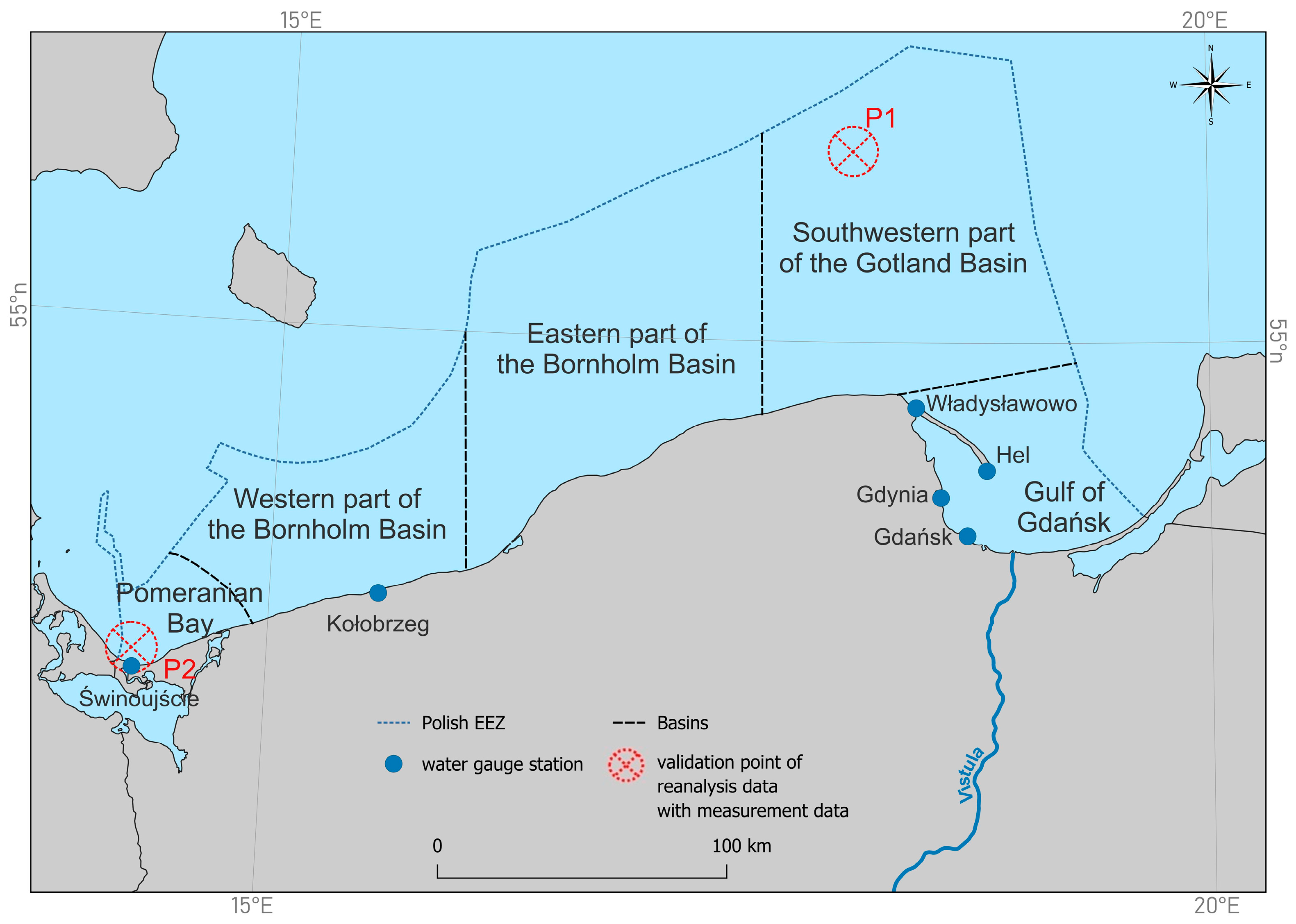

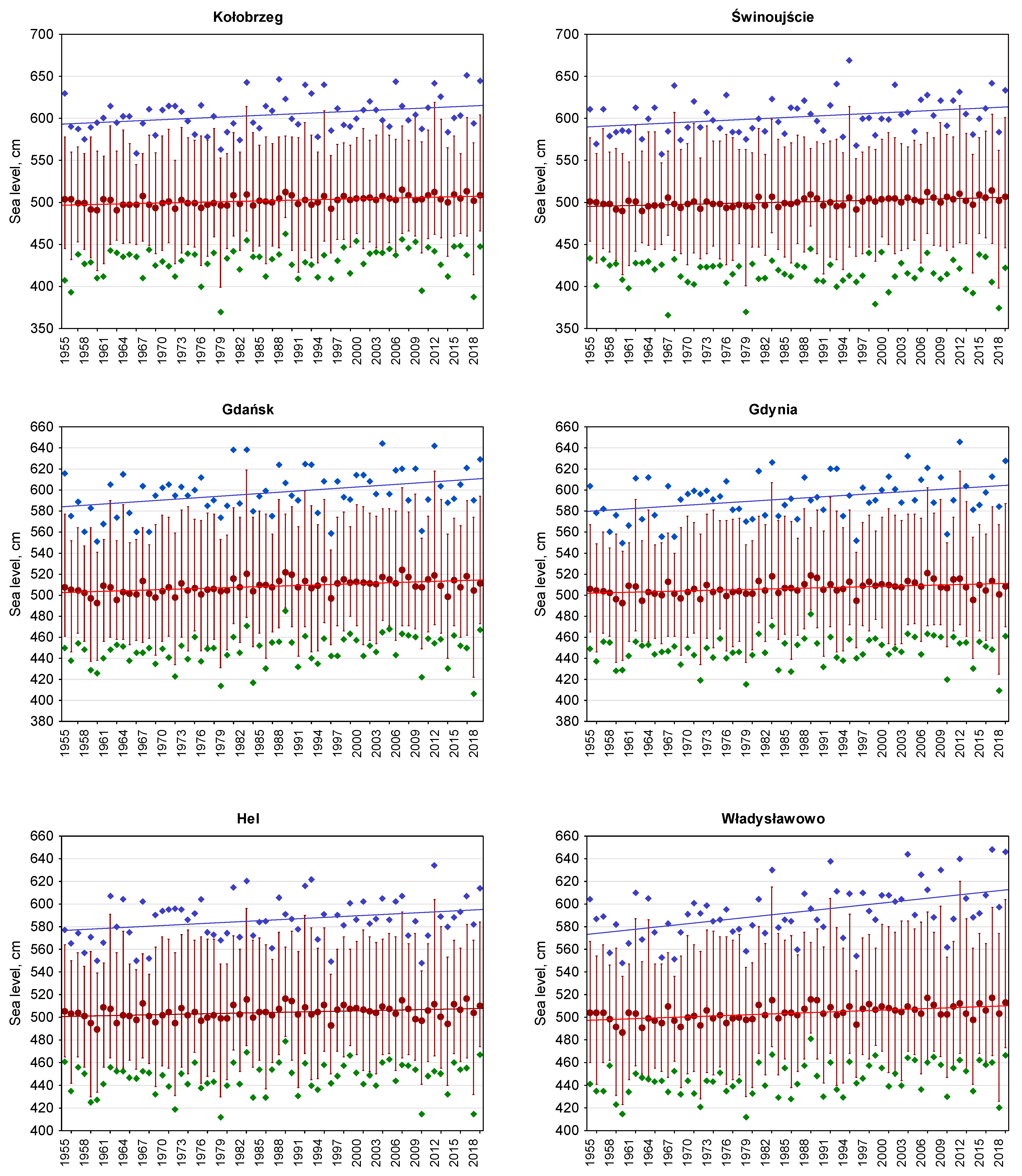
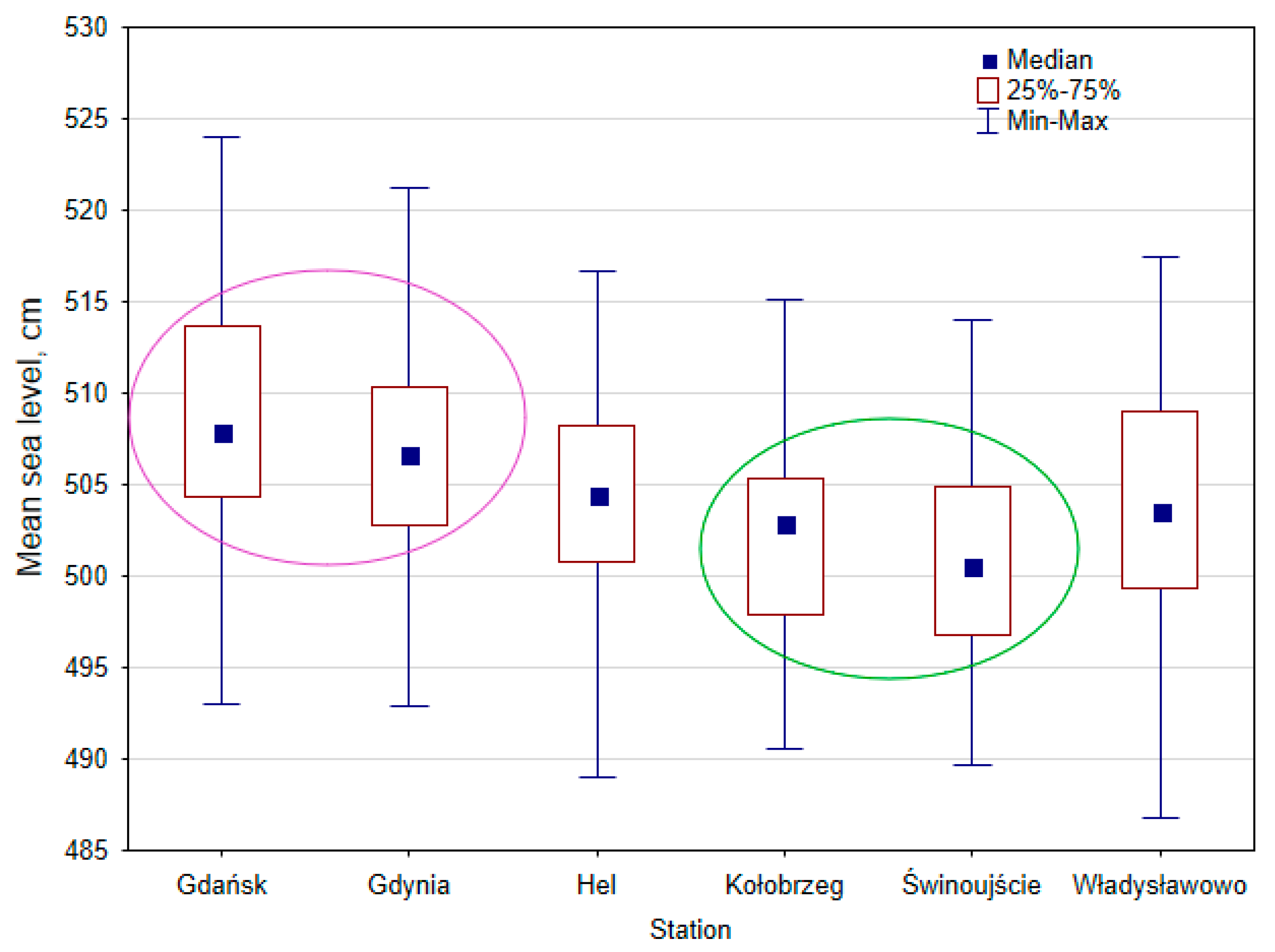


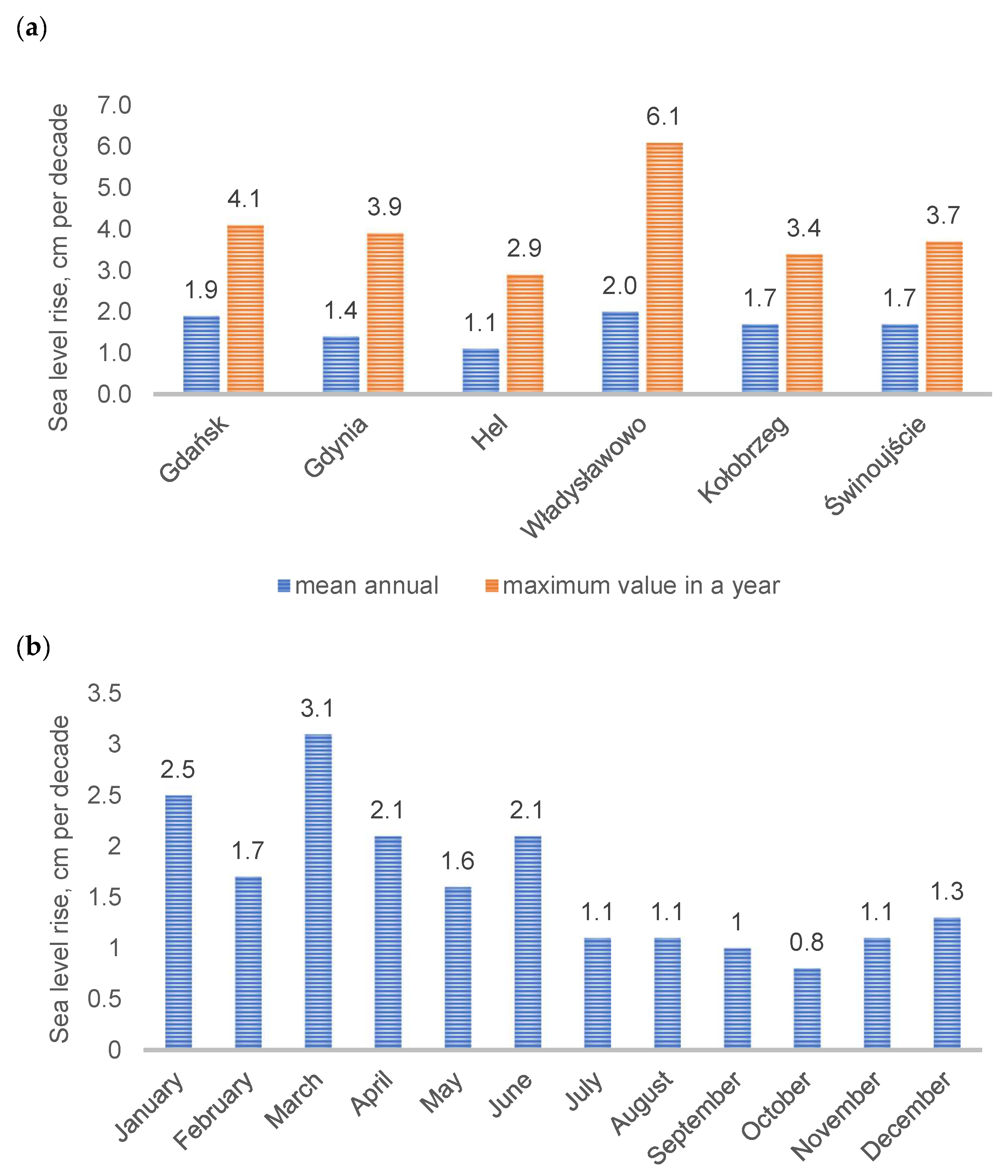
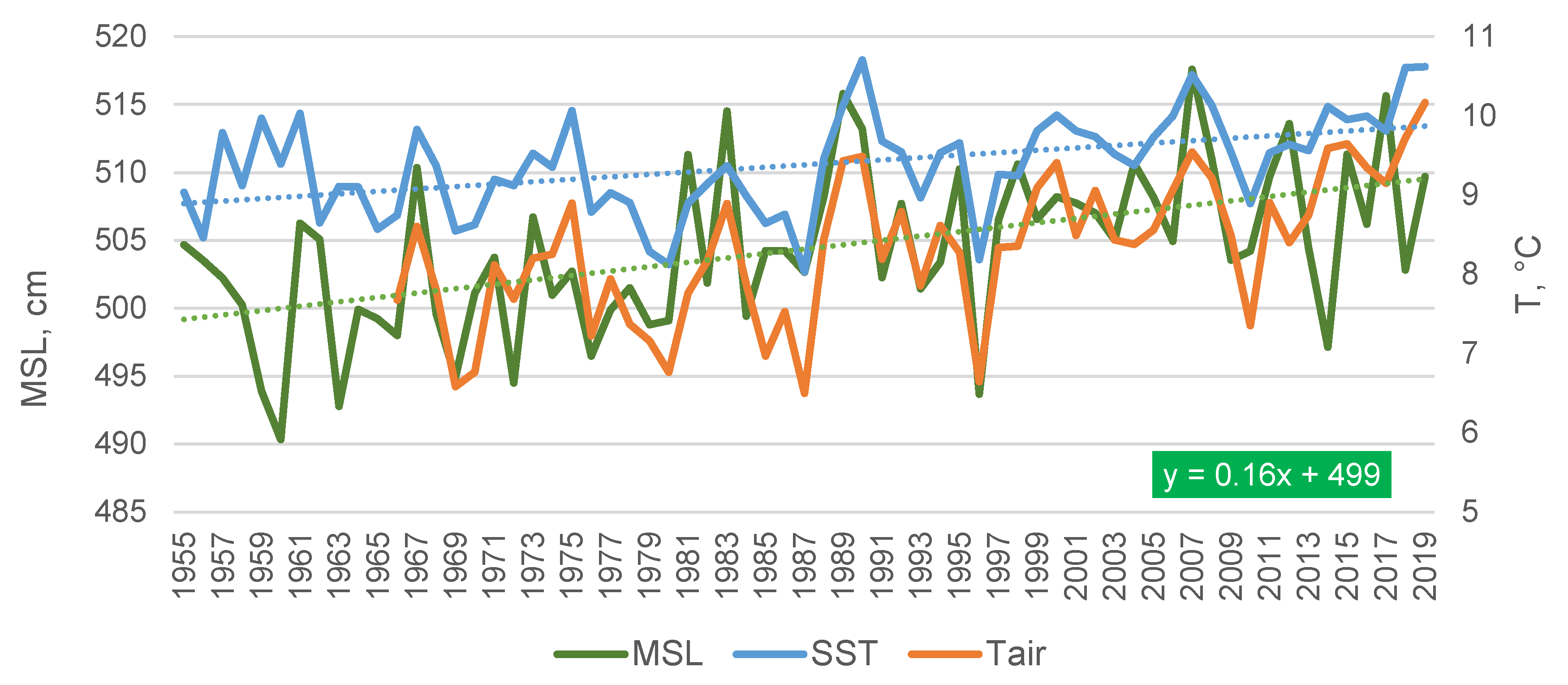
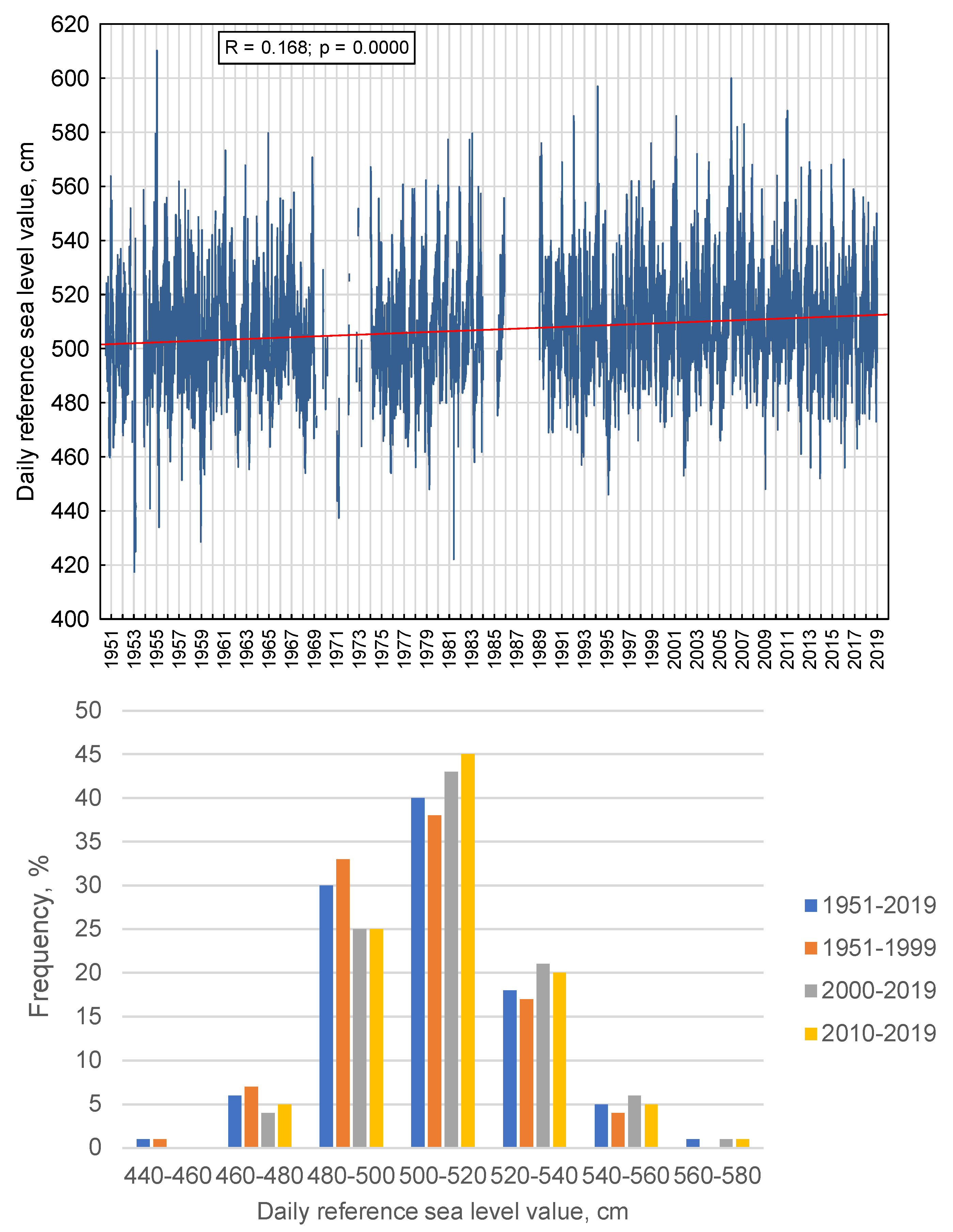

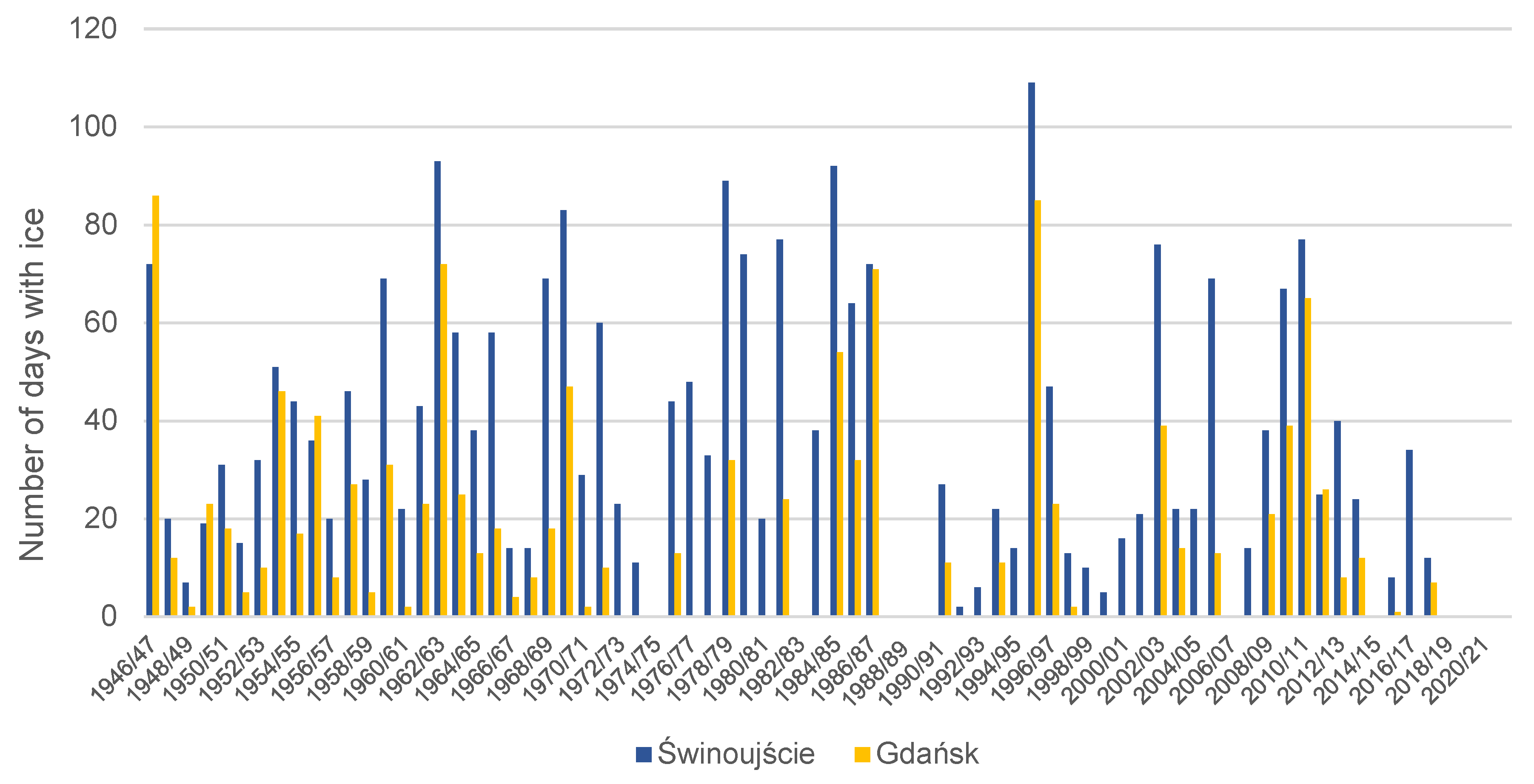
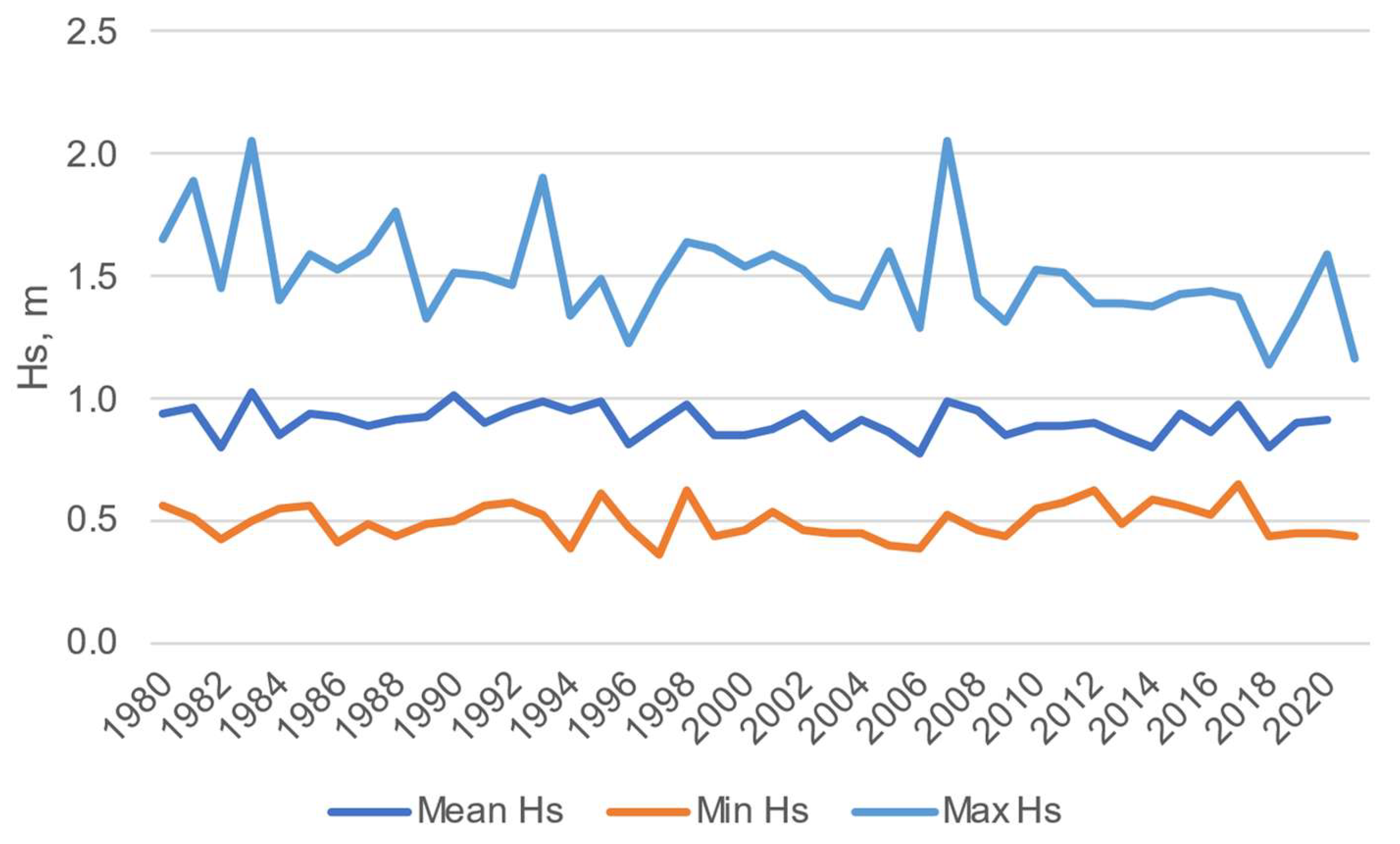
| Sea Surface Temperature (SST) | Air Temperature at 2 m | |
|---|---|---|
| All stations | 0.528 | 0.630 |
| Gdańsk | 0.465 | 0.559 |
| Gdynia | 0.549 | |
| Hel | 0.563 | 0.591 |
| Kołobrzeg | 0.433 | 0.687 |
| Świnoujście | 0.310 | 0.616 |
| Władysławowo | 0.646 |
| Basin | Western Part of the Bornholm Basin | Southwestern Part of the Gotland Basin | Eastern Part of the Bornholm Basin | Gulf of Gdańsk | Pomeranian Bay | |||||
|---|---|---|---|---|---|---|---|---|---|---|
 |  |  |  |  | ||||||
| Hs [m] | TSTORM [h] | Hs [m] | TSTORM [h] | Hs [m] | TSTORM [h] | Hs [m] | TSTORM [h] | Hs [m] | TSTORM [h] | |
| 1980 | 1.1 | 432 | 1.6 | 654 | 1.7 | 705 | 1.2 | 87 | 0.8 | 33 |
| 1981 | 1.3 | 231 | 1.7 | 465 | 1.8 | 393 | 0.9 | 72 | 0.7 | 6 |
| 1982 | 1.0 | 582 | 1.4 | 1011 | 1.4 | 1011 | 0.9 | 171 | 0.6 | 18 |
| 1983 | 1.3 | 348 | 1.7 | 441 | 1.7 | 582 | 0.7 | 33 | 0.7 | 0 |
| 1984 | 0.9 | 315 | 1.3 | 498 | 1.2 | 537 | 0.8 | 69 | 0.6 | 24 |
| 1985 | 1.1 | 270 | 1.2 | 546 | 1.3 | 609 | 0.8 | 84 | 0.6 | 27 |
| 1986 | 1.1 | 246 | 1.3 | 531 | 1.4 | 450 | 0.7 | 33 | 0.7 | 12 |
| 1987 | 1.3 | 231 | 1.3 | 639 | 1.4 | 660 | 1.2 | 141 | 0.7 | 21 |
| 1988 | 1.3 | 306 | 1.7 | 759 | 1.3 | 777 | 1.0 | 108 | 0.8 | 12 |
| 1989 | 1.1 | 417 | 1.5 | 846 | 1.1 | 882 | 0.7 | 30 | 0.7 | 9 |
| 1990 | 1.2 | 240 | 1.3 | 549 | 1.5 | 588 | 0.7 | 24 | 0.6 | 0 |
| 1991 | 0.9 | 354 | 1.2 | 657 | 1.1 | 651 | 1.0 | 93 | 0.5 | 9 |
| 1992 | 1.0 | 381 | 1.5 | 666 | 1.2 | 795 | 0.9 | 90 | 0.6 | 15 |
| 1993 | 1.2 | 351 | 1.7 | 603 | 1.7 | 672 | 0.6 | 36 | 0.7 | 0 |
| 1994 | 0.9 | 486 | 1.1 | 657 | 1.2 | 855 | 0.9 | 66 | 0.5 | 57 |
| 1995 | 1.2 | 273 | 1.2 | 369 | 1.3 | 522 | 0.7 | 27 | 0.8 | 15 |
| 1996 | 1.2 | 258 | 1.1 | 519 | 1.2 | 489 | 0.9 | 69 | 0.7 | 21 |
| 1997 | 1.1 | 285 | 1.3 | 525 | 1.2 | 669 | 1.0 | 36 | 0.7 | 0 |
| 1998 | 0.9 | 261 | 1.5 | 537 | 1.1 | 531 | 1.0 | 66 | 0.6 | 15 |
| 1999 | 1.2 | 243 | 2.0 | 381 | 2.1 | 465 | 0.8 | 57 | 0.7 | 18 |
| 2000 | 1.3 | 324 | 1.2 | 594 | 1.3 | 573 | 0.8 | 108 | 0.7 | 0 |
| 2001 | 1.1 | 348 | 1.3 | 462 | 1.3 | 582 | 0.9 | 42 | 0.6 | 21 |
| 2002 | 1.2 | 276 | 1.6 | 552 | 1.5 | 591 | 0.9 | 117 | 0.8 | 6 |
| 2003 | 1.1 | 276 | 1.3 | 528 | 1.3 | 576 | 1.0 | 57 | 0.7 | 15 |
| 2004 | 1.3 | 252 | 1.5 | 429 | 1.4 | 456 | 0.7 | 15 | 0.7 | 0 |
| 2005 | 1.1 | 132 | 1.5 | 306 | 1.5 | 351 | 0.8 | 33 | 0.5 | 15 |
| 2006 | 1.1 | 417 | 1.2 | 657 | 1.2 | 717 | 0.9 | 72 | 0.7 | 12 |
| 2007 | 1.1 | 384 | 1.7 | 675 | 1.5 | 762 | 0.8 | 72 | 0.7 | 12 |
| 2008 | 1.0 | 246 | 1.4 | 357 | 1.3 | 369 | 1.0 | 48 | 0.6 | 27 |
| 2009 | 1.2 | 426 | 1.5 | 369 | 1.5 | 657 | 0.6 | 12 | 0.7 | 6 |
| 2010 | 1.1 | 282 | 1.0 | 648 | 1.2 | 621 | 1.0 | 42 | 0.6 | 3 |
| 2011 | 1.0 | 264 | 1.6 | 492 | 1.4 | 456 | 0.9 | 33 | 0.6 | 3 |
| 2012 | 0.9 | 261 | 1.2 | 390 | 1.2 | 474 | 0.8 | 60 | 0.6 | 24 |
| 2013 | 1.5 | 225 | 1.2 | 270 | 1.7 | 405 | 0.7 | 30 | 0.7 | 3 |
| 2014 | 1.1 | 342 | 1.3 | 606 | 1.2 | 666 | 0.9 | 87 | 0.7 | 6 |
| 2015 | 1.2 | 261 | 1.7 | 513 | 1.5 | 570 | 0.8 | 69 | 0.6 | 18 |
| 2016 | 1.2 | 366 | 1.2 | 540 | 1.4 | 660 | 0.9 | 87 | 0.7 | 3 |
| 2017 | 1.1 | 270 | 1.3 | 363 | 1.3 | 438 | 0.9 | 24 | 0.6 | 0 |
| 2018 | 1.0 | 249 | 1.3 | 429 | 1.1 | 504 | 1.1 | 54 | 0.6 | 3 |
| 2019 | 0.9 | 414 | 1.6 | 549 | 1.2 | 606 | 1.1 | 78 | 0.6 | 3 |
| 2020 | 0.9 | 342 | 1.7 | 606 | 1.3 | 666 | 0.9 | 87 | 0.6 | 6 |
| 2021 | 1.2 | 314 | 1.7 | 546 | 1.5 | 614 | 0.9 | 77 | 0.6 | 5 |
| Basin | Western Part of the Bornholm Basin | Southwestern Part of the Gotland Basin | Eastern Part of the Bornholm Basin | Gulf of Gdańsk | Pomeranian Bay | |||||
|---|---|---|---|---|---|---|---|---|---|---|
 |  |  |  |  | ||||||
| Hs [m] | Sea Level [m] | Hs [m] | Sea Level [m] | Hs [m] | Sea Level [m] | Hs [m] | Sea Level [m] | Hs [m] | Sea Level [m] | |
| I | 1.24 | 0.012 | 1.41 | 0.044 | 1.54 | 0.037 | 0.73 | 0.050 | 0.66 | −0.020 |
| II | 1.22 | −0.018 | 1.39 | 0.012 | 1.52 | 0.006 | 0.68 | 0.018 | 0.59 | −0.036 |
| III | 0.88 | −0.065 | 1.11 | −0.042 | 1.21 | −0.054 | 0.66 | −0.024 | 0.53 | −0.059 |
| IV | 0.72 | −0.058 | 0.66 | −0.052 | 0.86 | −0.064 | 0.51 | −0.046 | 0.45 | −0.075 |
| V | 0.68 | −0.069 | 0.59 | −0.060 | 0.95 | −0.055 | 0.50 | −0.045 | 0.44 | −0.074 |
| VI | 0.72 | 0.031 | 0.52 | 0.046 | 0.98 | 0.036 | 0.50 | 0.066 | 0.48 | 0.026 |
| VII | 0.64 | 0.115 | 0.46 | 0.141 | 0.92 | 0.120 | 0.54 | 0.156 | 0.49 | 0.105 |
| VIII | 0.85 | 0.097 | 0.78 | 0.114 | 1.22 | 0.102 | 0.55 | 0.122 | 0.58 | 0.085 |
| IX | 1.10 | 0.098 | 1.19 | 0.108 | 1.76 | 0.101 | 0.80 | 0.127 | 0.61 | 0.078 |
| X | 1.14 | 0.069 | 1.43 | 0.089 | 1.60 | 0.084 | 0.85 | 0.099 | 0.70 | 0.049 |
| XI | 1.30 | 0.051 | 1.57 | 0.079 | 1.81 | 0.083 | 0.90 | 0.940 | 0.70 | 0.041 |
| XII | 1.51 | 0.046 | 1.76 | 0.052 | 1.82 | 0.046 | 0.95 | 0.790 | 0.77 | 0.006 |
| January | February | March | April | May | June | July | August | September | October | November | December | |||||||||||||
|---|---|---|---|---|---|---|---|---|---|---|---|---|---|---|---|---|---|---|---|---|---|---|---|---|
| Hs | NAO | Hs | NAO | Hs | NAO | Hs | NAO | Hs | NAO | Hs | NAO | Hs | NAO | Hs | NAO | Hs | NAO | Hs | NAO | Hs | NAO | Hs | NAO | |
| 1980 | 0.9 | −0.8 | 0.7 | 0.1 | 1.0 | −0.3 | 0.7 | 1.3 | 0.6 | −1.5 | 0.6 | −0.4 | 0.7 | −0.4 | 1.0 | −2.2 | 0.8 | 0.7 | 1.3 | −1.8 | 1.4 | −0.4 | 1.7 | 0.8 |
| 1981 | 1.4 | 0.4 | 1.3 | 0.9 | 0.9 | −1.2 | 0.7 | 0.4 | 0.5 | 0.2 | 0.7 | −0.5 | 0.6 | 0.1 | 0.8 | 0.4 | 0.5 | −1.5 | 1.2 | −1.4 | 1.9 | −0.4 | 1.2 | 0.0 |
| 1982 | 1.4 | −0.9 | 0.4 | 1.2 | 0.8 | 1.2 | 0.8 | 0.1 | 0.5 | −0.5 | 0.6 | −1.6 | 0.5 | 1.2 | 0.8 | 0.3 | 0.7 | 1.8 | 0.7 | −0.7 | 1.2 | 1.6 | 1.2 | 1.8 |
| 1983 | 2.1 | 1.6 | 1.1 | −0.5 | 0.7 | 1.0 | 0.7 | −0.9 | 0.5 | −0.1 | 0.6 | 1.0 | 0.7 | 1.2 | 0.6 | 1.6 | 1.1 | −1.1 | 1.6 | 0.7 | 1.4 | −1.0 | 1.3 | 0.3 |
| 1984 | 1.4 | 1.7 | 0.7 | 0.7 | 0.7 | −0.4 | 0.6 | −0.3 | 0.5 | 0.5 | 0.9 | −0.4 | 0.8 | −0.1 | 0.6 | 1.2 | 1.0 | 0.2 | 1.2 | −0.1 | 1.0 | −0.1 | 0.9 | 0.0 |
| 1985 | 1.2 | −1.6 | 1.6 | −0.5 | 0.7 | 0.2 | 0.7 | 0.3 | 0.6 | −0.5 | 0.6 | −0.8 | 0.6 | 1.2 | 0.6 | −0.5 | 1.3 | −0.5 | 0.9 | 0.9 | 1.3 | −0.7 | 1.1 | 0.2 |
| 1986 | 1.4 | 1.1 | 1.2 | −1.0 | 0.6 | 1.7 | 0.9 | −0.6 | 0.4 | 0.9 | 0.5 | 1.2 | 0.7 | 0.1 | 0.6 | −1.1 | 1.2 | −1.1 | 1.0 | 1.6 | 1.2 | 2.3 | 1.5 | 1.0 |
| 1987 | 1.6 | −1.2 | 0.7 | −0.7 | 1.2 | 0.1 | 0.6 | 2.0 | 0.6 | 1.0 | 0.5 | −1.8 | 0.7 | 0.5 | 0.7 | −0.8 | 1.0 | −1.2 | 0.7 | 0.1 | 0.9 | 0.2 | 1.3 | 0.3 |
| 1988 | 0.9 | 1.0 | 1.0 | 0.8 | 0.9 | −0.2 | 0.7 | −1.2 | 0.4 | 0.6 | 0.6 | 0.9 | 0.5 | −0.4 | 0.7 | 0.0 | 1.1 | −1.0 | 1.0 | −1.1 | 1.3 | −0.3 | 1.8 | 0.6 |
| 1989 | 1.3 | 1.2 | 1.3 | 2.0 | 0.9 | 1.9 | 0.7 | 0.3 | 0.5 | 1.4 | 0.5 | −0.3 | 0.8 | 1.0 | 0.9 | 0.0 | 0.6 | 2.1 | 1.2 | 0.0 | 1.1 | 0.2 | 1.3 | −1.2 |
| 1990 | 1.4 | 1.0 | 1.4 | 1.4 | 1.5 | 1.5 | 0.7 | 2.0 | 0.5 | −1.5 | 0.5 | 0.0 | 0.9 | 0.5 | 0.6 | 1.0 | 1.2 | 1.1 | 1.0 | 0.2 | 1.1 | −0.2 | 1.3 | 0.2 |
| 1991 | 1.2 | 0.9 | 1.2 | 1.0 | 0.6 | −0.2 | 0.6 | 0.3 | 0.8 | 0.1 | 0.7 | −0.8 | 0.6 | −0.5 | 0.8 | 1.2 | 0.8 | 0.5 | 1.0 | −0.2 | 1.1 | 0.5 | 1.5 | 0.5 |
| 1992 | 1.4 | −0.1 | 1.2 | 1.1 | 1.0 | 0.9 | 0.7 | 1.9 | 0.6 | 2.6 | 0.6 | 0.2 | 0.7 | 0.2 | 0.7 | 0.9 | 0.9 | −0.4 | 1.1 | −1.8 | 1.5 | 1.2 | 0.9 | 0.5 |
| 1993 | 1.9 | 1.6 | 1.2 | 0.5 | 1.1 | 0.7 | 0.6 | 1.0 | 0.5 | −0.8 | 0.8 | −0.6 | 0.9 | −3.2 | 0.8 | 0.1 | 0.9 | −0.6 | 0.8 | −0.7 | 0.9 | 2.6 | 1.4 | 1.6 |
| 1994 | 1.3 | 1.0 | 0.8 | 0.5 | 1.3 | 1.3 | 0.6 | 1.1 | 0.7 | −0.6 | 0.9 | 1.5 | 0.4 | 1.3 | 0.8 | 0.4 | 1.0 | −1.3 | 1.1 | −1.0 | 1.3 | 0.6 | 1.2 | 2.0 |
| 1995 | 1.5 | 0.9 | 1.5 | 1.1 | 1.2 | 1.3 | 1.1 | −0.9 | 0.7 | −1.5 | 0.6 | 0.1 | 0.6 | −0.2 | 0.8 | 0.7 | 1.1 | 0.3 | 0.8 | 0.2 | 1.2 | −1.4 | 0.9 | −1.7 |
| 1996 | 0.7 | −0.1 | 1.1 | −0.1 | 0.7 | −0.2 | 0.6 | −0.2 | 0.8 | −1.1 | 0.6 | 0.6 | 0.8 | 0.7 | 0.5 | 1.0 | 1.1 | −0.9 | 0.6 | −0.3 | 1.2 | −0.6 | 1.0 | −1.4 |
| 1997 | 0.7 | −0.5 | 1.5 | 1.7 | 1.0 | 1.5 | 1.1 | −1.0 | 0.7 | −0.3 | 0.6 | −1.5 | 0.6 | 0.3 | 0.4 | 0.8 | 1.2 | 0.6 | 1.4 | −1.7 | 0.7 | −0.9 | 0.9 | −1.0 |
| 1998 | 1.2 | 0.4 | 1.5 | −0.1 | 1.1 | 0.9 | 0.6 | −0.7 | 0.6 | −1.3 | 0.7 | −2.7 | 0.8 | −0.5 | 1.0 | 0.0 | 0.6 | −2.0 | 1.6 | −0.3 | 0.8 | −0.3 | 1.1 | 0.9 |
| 1999 | 1.0 | 0.8 | 1.3 | 0.3 | 0.6 | 0.2 | 0.8 | −1.0 | 0.5 | 0.9 | 0.4 | 1.1 | 0.6 | −0.9 | 0.7 | 0.4 | 0.5 | 0.4 | 1.2 | 0.2 | 1.0 | 0.7 | 1.6 | 1.6 |
| 2000 | 1.5 | 0.6 | 1.2 | 1.7 | 1.3 | 0.8 | 0.5 | 0.0 | 0.5 | 1.6 | 0.8 | 0.0 | 0.7 | −1.0 | 0.6 | −0.3 | 0.7 | −0.2 | 0.7 | 0.9 | 0.7 | −0.9 | 0.8 | −0.6 |
| 2001 | 0.7 | 0.3 | 1.2 | 0.5 | 0.8 | −1.3 | 0.7 | 0.0 | 0.7 | 0.0 | 0.6 | −0.2 | 0.5 | −0.3 | 0.8 | −0.1 | 0.8 | −0.7 | 0.9 | −0.2 | 1.6 | 0.6 | 1.3 | −0.8 |
| 2002 | 1.5 | 0.4 | 1.5 | 1.1 | 1.1 | 0.7 | 0.5 | 1.2 | 0.5 | −0.2 | 0.8 | 0.4 | 0.7 | 0.6 | 0.5 | 0.4 | 0.8 | −0.7 | 1.3 | −2.3 | 0.9 | −0.2 | 0.9 | −0.9 |
| 2003 | 1.2 | 0.2 | 0.6 | 0.6 | 0.6 | 0.3 | 0.9 | −0.2 | 0.4 | 0.0 | 0.8 | −0.1 | 0.5 | 0.1 | 0.9 | −0.1 | 0.7 | 0.0 | 1.2 | −1.3 | 0.7 | 0.9 | 1.4 | 0.6 |
| 2004 | 1.0 | −0.3 | 1.1 | −0.1 | 1.0 | 1.0 | 0.5 | 1.2 | 0.7 | 0.2 | 0.8 | −0.9 | 0.6 | 1.1 | 0.6 | −0.5 | 1.1 | 0.4 | 0.9 | −1.1 | 1.4 | 0.7 | 1.2 | 1.2 |
| 2005 | 1.6 | 1.5 | 1.2 | −0.1 | 1.0 | −1.8 | 0.6 | −0.3 | 0.4 | −1.3 | 0.7 | −0.1 | 0.6 | −0.5 | 0.8 | 0.4 | 0.6 | 0.6 | 0.8 | −1.0 | 1.0 | −0.3 | 1.2 | −0.4 |
| 2006 | 0.8 | 1.3 | 0.8 | −0.5 | 0.8 | −1.3 | 0.5 | 1.2 | 0.6 | −1.1 | 0.4 | 0.8 | 0.4 | 0.9 | 0.7 | −1.7 | 0.7 | −1.6 | 0.9 | −2.2 | 1.3 | 0.4 | 1.3 | 1.3 |
| 2007 | 2.1 | 0.2 | 1.1 | −0.5 | 0.9 | 1.4 | 0.8 | 0.2 | 0.5 | 0.7 | 0.7 | −1.3 | 0.9 | −0.6 | 0.7 | −0.1 | 1.0 | 0.7 | 0.8 | 0.5 | 1.3 | 0.6 | 1.0 | 0.3 |
| 2008 | 1.3 | 0.9 | 1.3 | 0.7 | 1.1 | 0.1 | 0.6 | −1.1 | 0.5 | −1.7 | 0.7 | −1.4 | 0.6 | −1.3 | 0.9 | −1.2 | 0.8 | 1.0 | 1.1 | 0.0 | 1.4 | −0.3 | 0.8 | −0.3 |
| 2009 | 1.0 | 0.0 | 1.0 | 0.1 | 0.8 | 0.6 | 0.4 | −0.2 | 0.7 | 1.7 | 0.9 | −1.2 | 0.6 | −2.2 | 0.7 | −0.2 | 0.9 | 1.5 | 1.3 | −1.0 | 1.0 | 0.0 | 0.8 | −1.9 |
| 2010 | 1.1 | −1.1 | 0.8 | −2.0 | 0.8 | −0.9 | 0.6 | −0.7 | 0.7 | −1.5 | 0.5 | −0.8 | 0.6 | −0.4 | 0.7 | −1.2 | 1.2 | −0.8 | 0.9 | −0.9 | 1.2 | −1.6 | 1.5 | −1.9 |
| 2011 | 0.9 | −0.9 | 1.3 | 0.7 | 0.9 | 0.6 | 0.8 | 2.5 | 0.6 | −0.1 | 0.6 | −1.3 | 0.7 | −1.5 | 0.8 | −1.4 | 0.9 | 0.5 | 1.0 | 0.4 | 0.8 | 1.4 | 1.5 | 2.5 |
| 2012 | 1.4 | 1.2 | 1.3 | 0.4 | 0.9 | 1.3 | 0.7 | 0.5 | 0.6 | −0.9 | 0.7 | −2.5 | 0.6 | −1.3 | 0.6 | −1.0 | 1.0 | −0.6 | 1.0 | −2.1 | 0.9 | −0.6 | 1.0 | 0.2 |
| 2013 | 1.1 | 0.4 | 0.9 | −0.5 | 1.1 | −1.6 | 0.6 | 0.7 | 0.5 | 0.6 | 0.6 | 0.5 | 0.7 | 0.7 | 0.6 | 1.0 | 0.8 | 0.2 | 0.9 | −1.3 | 1.1 | 0.9 | 1.4 | 1.0 |
| 2014 | 1.3 | 0.3 | 0.6 | 1.3 | 0.8 | 0.8 | 0.6 | 0.3 | 0.7 | −0.9 | 0.6 | −1.0 | 0.6 | 0.2 | 0.8 | −1.7 | 0.8 | 1.6 | 0.7 | −1.3 | 0.7 | 0.7 | 1.4 | 1.9 |
| 2015 | 1.4 | 1.8 | 0.9 | 1.3 | 0.9 | 1.5 | 0.9 | 0.7 | 0.7 | 0.2 | 0.6 | −0.1 | 0.9 | −3.2 | 0.6 | −0.8 | 0.8 | −0.7 | 0.8 | 0.4 | 1.3 | 1.7 | 1.4 | 2.2 |
| 2016 | 1.0 | 0.1 | 1.1 | 1.6 | 0.6 | 0.7 | 0.7 | 0.4 | 0.5 | −0.8 | 0.5 | −0.4 | 0.7 | −1.8 | 0.8 | −1.7 | 0.5 | 0.6 | 1.3 | 0.4 | 1.3 | −0.2 | 1.4 | 0.5 |
| 2017 | 1.1 | 0.5 | 1.0 | 1.0 | 0.8 | 0.7 | 0.9 | 1.7 | 0.7 | −1.9 | 0.9 | 0.1 | 0.7 | 1.3 | 0.7 | −1.1 | 0.9 | −0.6 | 1.4 | 0.2 | 1.1 | 0.0 | 1.4 | 0.9 |
| 2018 | 1.0 | 1.4 | 0.8 | 1.6 | 0.8 | −0.9 | 0.7 | 1.2 | 0.4 | 2.1 | 0.7 | 1.1 | 0.6 | 1.4 | 0.7 | 2.0 | 1.0 | 1.7 | 1.1 | 0.9 | 0.7 | −0.1 | 1.0 | 0.6 |
| 2019 | 1.3 | 0.6 | 1.0 | 0.3 | 1.1 | 1.2 | 0.7 | 0.5 | 0.8 | −2.6 | 0.5 | −1.1 | 0.9 | −1.4 | 0.5 | −1.2 | 1.1 | −0.2 | 0.9 | −1.4 | 0.8 | 0.3 | 1.2 | 1.2 |
| 2020 | 1.3 | 1.3 | 1.6 | 1.3 | 0.9 | 1.0 | 0.8 | −1.0 | 0.8 | −0.4 | 0.6 | −0.2 | 0.9 | −1.2 | 0.5 | 0.1 | 0.8 | 1.0 | 1.1 | −0.7 | 1.1 | 2.5 | 0.9 | −0.3 |
| 2021 | 1.1 | −1.1 | 1.0 | 0.1 | 0.9 | 0.7 | 0.9 | −1.4 | 0.6 | −1.2 | 0.4 | 0.8 | 0.6 | 0.0 | 0.9 | −0.3 | 0.8 | −0.2 | 1.0 | −2.3 | 1.1 | −0.2 | 1.2 | 0.3 |
| R | 0.37 | 0.19 | 0.26 | −0.13 | −0.3 | −0.19 | −0.24 | −0.23 | −0.15 | −0.09 | −0.11 | 0.55 | ||||||||||||
Disclaimer/Publisher’s Note: The statements, opinions and data contained in all publications are solely those of the individual author(s) and contributor(s) and not of MDPI and/or the editor(s). MDPI and/or the editor(s) disclaim responsibility for any injury to people or property resulting from any ideas, methods, instructions or products referred to in the content. |
© 2025 by the authors. Licensee MDPI, Basel, Switzerland. This article is an open access article distributed under the terms and conditions of the Creative Commons Attribution (CC BY) license (https://creativecommons.org/licenses/by/4.0/).
Share and Cite
Zalewska, T.; Kowalska, B.; Krzysztofik, K.; Sapiega, P. Changes in Sea Level, Storm and Wave Conditions, and Ice Cover—Over 70 Years of Observation in the Southern Baltic Sea. Water 2025, 17, 680. https://doi.org/10.3390/w17050680
Zalewska T, Kowalska B, Krzysztofik K, Sapiega P. Changes in Sea Level, Storm and Wave Conditions, and Ice Cover—Over 70 Years of Observation in the Southern Baltic Sea. Water. 2025; 17(5):680. https://doi.org/10.3390/w17050680
Chicago/Turabian StyleZalewska, Tamara, Beata Kowalska, Katarzyna Krzysztofik, and Patryk Sapiega. 2025. "Changes in Sea Level, Storm and Wave Conditions, and Ice Cover—Over 70 Years of Observation in the Southern Baltic Sea" Water 17, no. 5: 680. https://doi.org/10.3390/w17050680
APA StyleZalewska, T., Kowalska, B., Krzysztofik, K., & Sapiega, P. (2025). Changes in Sea Level, Storm and Wave Conditions, and Ice Cover—Over 70 Years of Observation in the Southern Baltic Sea. Water, 17(5), 680. https://doi.org/10.3390/w17050680







